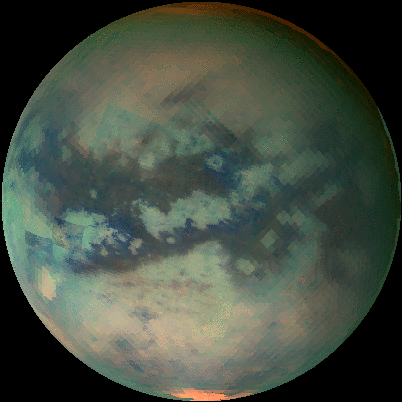 |
This is a file from the Wikimedia Commons. Information from its description page there is shown below.
Commons is a freely licensed media file repository. You can help.
|
Summary
| Description |
PIA02146.gif
English: This movie of Titan shows data taken with Cassini's visual and infrared mapping spectrometer during the last three flybys of Titan. The flybys took place on Oct. 28, 2005, Dec. 26, 2005, and Jan. 15, 2006. These false-colour images were taken at wavelengths of 1.6 microns shown in blue, 2.01 microns in green and 5 microns in red.
The viewing geometry of the December flyby is roughly on the opposite hemispheres of the flybys in October and January. There are several important features shown by the movie. First, the globe of Titan exhibits two major types of terrain. One is very bright, and a darker one seems to be concentrated near the equator. Titan also has two very bright regions, the large one known as Tui Reggio, and the other as Hotei Arcus. These regions are thought to be surface deposits, probably of volcanic origin, and may be water and/or carbon dioxide frozen from the vapor. The December flyby data show that the western margins of Tui Reggio have a complex flow-like structure consistent with eruptive phenomena. The reddish feature at the south pole is Titan's south polar cloud system, which was very bright during the December flyby. During the October and January flybys it is barely visible, indicating that the atmosphere over titan's south pole is very dynamic.
The Cassini-Huygens mission is a cooperative project of NASA, the European Space Agency and the Italian Space Agency. The Jet Propulsion Laboratory, a division of the California Institute of Technology in Pasadena, manages the mission for NASA's Science Mission Directorate, Washington, D.C. The Cassini orbiter was designed, developed and assembled at JPL. The visual and infrared mapping spectrometer team is based at the University of Arizona. For more information about the Cassini-Huygens mission http://saturn.jpl.nasa.gov/home/index.cfm The visual and infrared mapping spectrometer team homepage is at http://wwwvims.lpl.arizona.edu.
|
| Date |
10 February 2006 |
| Source |
http://photojournal.jpl.nasa.gov/catalog/PIA02146 |
| Author |
NASA/JPL/University of Arizona |
Licensing
| Public domainPublic domainfalsefalse |
 |
This file is in the public domain because it was solely created by NASA. NASA copyright policy states that "NASA material is not protected by copyright unless noted". (See Template:PD-USGov, NASA copyright policy page or JPL Image Use Policy.) |
|
|
|
Warnings:
- Use of NASA logos, insignia and emblems are restricted per US law 14 CFR 1221.
- The NASA website hosts a large number of images from the Soviet/ Russian space agency, and other non-American space agencies. These are not necessarily in the public domain.
- Materials based on Hubble Space Telescope data may be copyrighted if they are not explicitly produced by the STScI. See also {{ PD-Hubble}} and {{ Cc-Hubble}}.
- The SOHO (ESA & NASA) joint project implies that all materials created by its probe are copyrighted and require permission for commercial non-educational use.
- Images featured on the Astronomy Picture of the Day (APOD) web site may be copyrighted.
|
File usage
The following pages on Schools Wikipedia link to this image (list may be incomplete):
SOS Childrens Villages aims to make Wikipedia suitable for young learners. By supporting vulnerable children right through to adulthood, SOS Childrens Villages makes a lasting difference to the lives of thousands of people. Education is a key part of our work, and our schools provide high-quality teaching to the children in our care. Will you help another child today?





